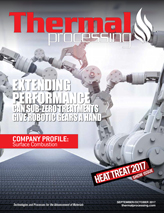One of the critical elements in the carburizing process is the ability to create a base atmosphere suitable for the parts placed inside a carburizing furnace. The focus of this article is the creation of gas in an endothermic generator.
Generator control systems have historically provided control of air/gas ratio and possibly a trim system, used to maintain a dew point that could be rich (too much gas) or lean (too much air). The dew point range could typically be between 30 degrees Fahrenheit and 50 degrees Fahrenheit. Flowmeters are provided to maintain a base ratio (2.7:1) for the air/gas mixture supplied to a retort filled with nickel-coated catalyst. The gas is then passed through an air cooler (some older systems used water) to freeze the reaction so the gas can be transported through a header system to furnaces. The ratio at which the gas is generated offers a dew point that can be measured. The trim control system allows for an automated adjustment of the air/gas mixture with the addition of more gas or more air. This compensates for changes that influence the dew point, such as weather conditions or spiking of the incoming gas by the gas supplier to maintain a specific BTU.
The makeup of the endothermic gas provided by a generator is typically 40 percent hydrogen, 40 percent nitrogen, and 20 percent carbon monoxide. Maintaining these percentages will result in a carburizing atmosphere that is conducive to best carburizing practices. So what can go wrong with a typical generator control trim system? Some potential issues include:
- Sticking float-type flowmeters.
- Air/gas ratio out of adjustment.
- Trim control valves not working.
- Catalyst depleted of the nickel or coated with soot.
- Unnecessary endothermic gas production resulting in wasted gas.
Nondispersive infrared analyzer (NDIR) systems are invaluable when trying to troubleshoot these issues. The analyzer will typically measure CO, CO2, and CH4. As mentioned earlier, if we know that 20 percent CO is being generated, we can cross-check the air/gas ratio and sticking flow meters, or determine that an adjustment of the air and/or gas ratio is required. The measurement for indication of sooted or nickel-depleted catalyst can also be achieved by using an analyzer. If the indicated measurement of CH4 is higher than 0.05 percent, a burnout of the catalyst is required, using the manufacturer’s required procedures. If, after a burnout, the CH4 level is still high, the catalyst may need to be replaced altogether.

The endothermic generator control systems sold today take all of these items to the next level, providing a better and more automated solution. Technology advancements have led the way for the next generation of endothermic generator control. Systems are now designed to fully automate a generator using microprocessors evaluating many digital and analog inputs such as temperature, dew point, and air/gas flow. They evaluate demand for endothermic gas and will automatically turn up and turn down the amount of gas. As described previously, the gas composition of the endothermic gas can be evaluated using NDIR to further make decisions on necessary steps for control and maintenance.
Temperature control loops for single- and multi-tube generators are built into the control hardware. The temperature of the gas leaving the generator is also monitored for heat exchanger performance by placing a deviation alarm around the practical temperature (<200°F) required to cool the gas prior to delivery in the header.
Dew point measurement and control can be achieved using a metal oxide polymer sensor or an oxygen sensor.
Differential pressure flowmeters using coarse adjustment technology allow the systems to measure the pressure through an orifice plate, then respond quickly using a highly accurate drive motor and sophisticated control loop algorithms for incremental adjustments to the system, keeping the air/gas ratio in the desired range.
The gas trim control uses the same technology as the coarse adjustment in tandem with the dew point measurement to achieve accurate control of the dew point. The best method of control when monitoring demand requires a fast control loop with logic that ensures the multi-variables are not conflicting with each other.
Electronic feedback from the flowmeters to the control system offers real-time digital monitoring of the air, gas, and total endothermic gas flows, with the ability to trend the results for historical review.
Demand for gas in a heat-treating facility can change due to a number of factors:
- Furnaces are added to or removed from service due to maintenance, production demands, or other issues.
- If batch integral quench furnaces are in use, charging and discharging loads also create variable demand for gas.
The multi-variable control systems implemented on generators will monitor demand by placing a sensor in the supply header. This sensor feeds back real-time demand to automate the supply of gas using a variable frequency drive (VFD) tied to the integral blower in the system for air and a variable flow meter for gas. As the demand changes, the VFD adjusts the blower speed and gas flow to compensate for the demand required. Typical systems have turndown capabilities of 5:1. Recovery from such demand changes is also an essential component in any automated system. The dew point should stabilize rapidly without manual intervention.
A modern generator with the latest in process-controls technology will also allow for easier operation with a graphical interface and built-in diagnostics for troubleshooting.
All these elements come together in SSi’s AutoGen system to form an easy-to-manage, automated, and adaptable system for producing endothermic gas more efficiently and accurately. AutoGen can help free up heat treaters to focus on other aspects of their processes, helping reduce downtime, increase effectiveness, and allow them to create better, more reliable products for their customers.































